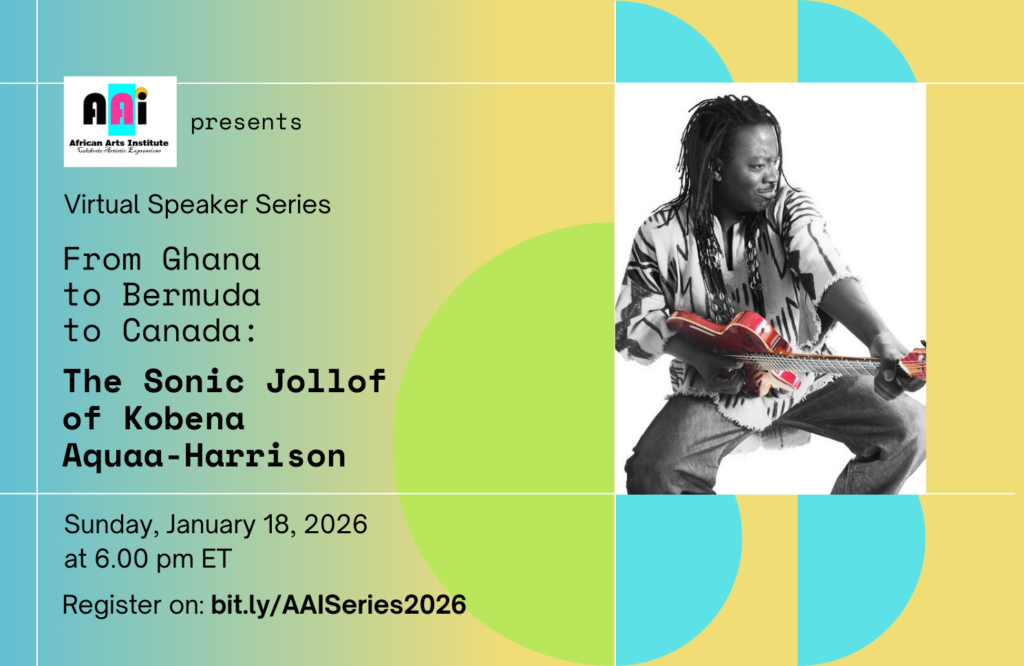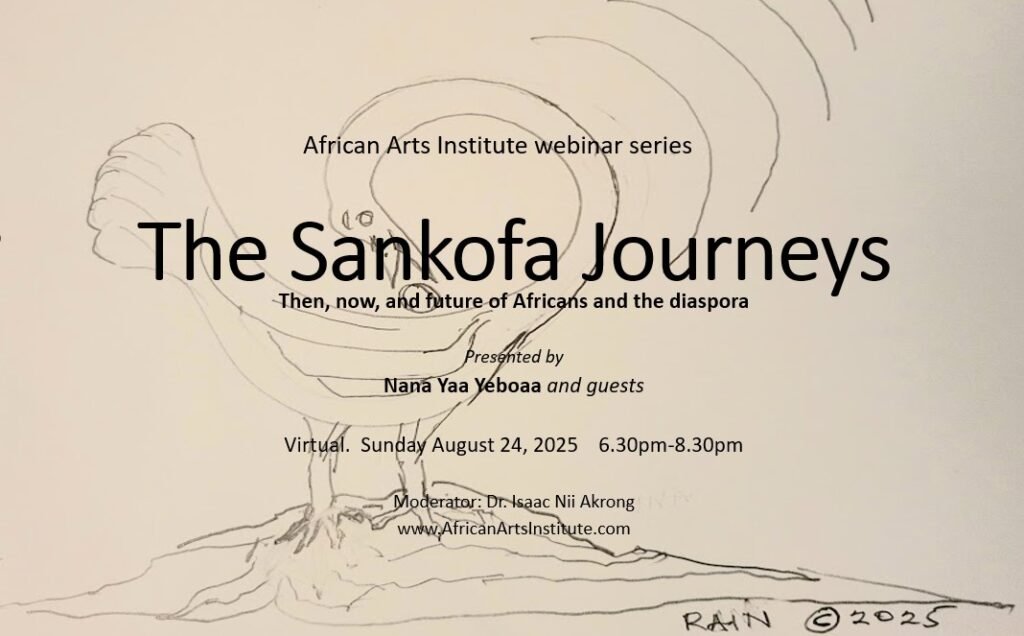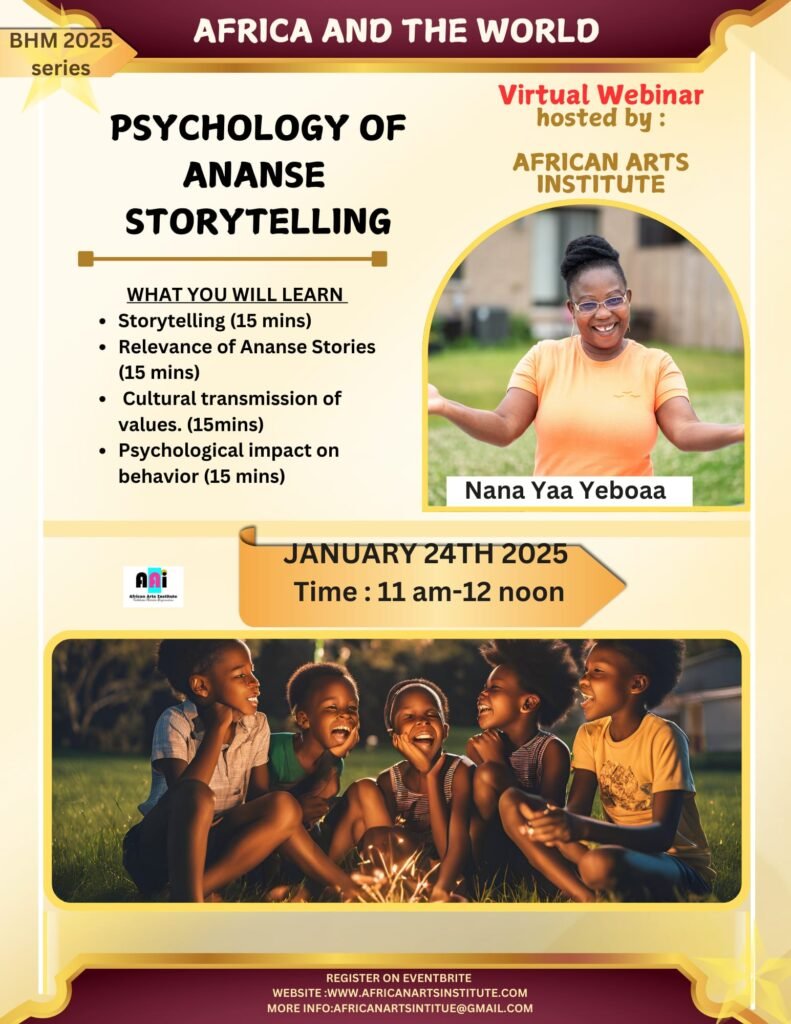Sankofa Journeys Speaker Series
The African Arts Institute (AAI) is proud to announce the launch of its 2026 Monthly Speaker Series: Sankofa Journeys, dedicated to showcasing African artists, scholars, and cultural practitioners shaping African arts today. Every session will be hosted by Dr. Isaac Nii Akrong, AAI’s President, and will highlight creative voices whose work preserves, reimagines, and celebrates African identity across disciplines.
Stay tuned to this page, or sign up for our newsletter to learn about upcoming events!
January 18, 2026 / From Ghana to Bermuda to Ghana: The Sonic Jollof of Kobèna Aquaa-Harrison
The first webinar will be taking place on Sunday, January 18, at 6:00 pm EST on Zoom and will feature the award-winning Ghanaian Bermudian multidisciplinary performer Kobèna Aquaa-Harrison, also known by Aquaa.

Based in Canada, Aquaa is renowned for his boundary-pushing work as a performer, producer, and composer, with accolades spanning music, media, film, television, dance, theatre, opera and community engagement. His performances, described as highly “edutaining,” seamlessly blend humour, animation, and interactivity as he engages audiences with true stories accompanied by his own electric and acoustic handmade instruments.
Aquaa’s signature genre – “sonic jollof” – brings jazz, reggae, rock, and blues into dialogue with their African ancestors. He is also the founder of the acclaimed Djungle Bouti Orchestra, a multicultural ensemble featuring artists from Algeria to Zimbabwe and from Trinidad to Tanzania. Their celebrated album, Djazz 2.1.4, nominated for a TIMA Independent Music Award, has been described as “an audio decoding of African DNA.”
From presidents to pre-schoolers, Aquaa has performed across continents, igniting laughter, dance, and reflection as he weaves together music, history, culture, and belonging. His unique ability to make every sound and story relatable promises an unforgettable opening event for the series.
The African Arts Institute invites all community members, artists, educators, and cultural enthusiasts to join us for this dynamic kickoff session.
Aquaa will be performing in Belleville on February 14, 2026, as part of the “Africa and the World” concert series.
Past Events / August 24, 2025: The Sankofa Journeys
This webinar took place on Sunday, August 24, at 6:30 pm EST and featured poet, storyteller, podcast host, and AAI board member Nana Yaa Yeboaa with AAI’s President Isaac Nii Akrong.
The event co-incided with the renaming of Toronto’s Dundas Square to Sankofa Square, and was the original “Sankofa Journeys” that inspired the series.

Sankofa Square: Memory, Identity, and Belonging in the Heart of Toronto — by Nana Yaa Yeboaa
A Name Holds Weight
The renaming of Toronto’s Dundas Square to Sankofa Square is more than a change in signage. It is a symbolic act that touches on history, memory, and justice. For people of Ghanaian descent in Canada, it honors the philosophy of Sankofa, a powerful Akan concept rooted in history, identity, and continuity. For Indigenous peoples, it resonates with their own struggles to reclaim language, leadership, and cultural practices lost through colonialism. And for the broader Canadian society, it signals a shift from colonial commemoration to an embrace of plurality, resilience, and shared histories.
Sankofa and the African Diaspora
In the Akan language of Ghana, Sankofa is often translated as “go back and fetch it.” Yet this phrase does not capture the profound depth of its meaning. Sankofa is symbolized by a bird that turns its head backward while its body faces forward embodying the truth that in order to move ahead, one must first look back. It is a philosophy of memory, identity, and responsibility. Its philosophy also touches on the immense knowledge and truths that nature teaches only if we are still and pay attention.
For the descendants of enslaved Africans, Sankofa reminds us of the lives disrupted by slavery. Those taken from the coast of West Africa, including Ghana who were blacksmiths, ironworkers, and artisans whose skills were central to their societies carried it with them to the East Coast of the United States. In their craft was not only function but spirituality and symbolism, which can be found in the iron works. Through iron, they expressed resilience and community values, the very spirit of Sankofa. To rename a square in Toronto after this philosophy is to honor their memory, a collective human story, ensuring that their knowledge and contributions are not lost to time.
The Akan proverb states, “A child that knows the way home does not get lost.” Sankofa teaches African diasporic communities that reconnecting with ancestral memory is a way of finding home, even in lands far from Africa. The name Sankofa Square, therefore, is a call to identity, belonging, and cultural pride for generations of other Africans living in Canada and to indigenous populations, a reclamation and reaffirmation.
Memory as Resistance
Public spaces are never neutral. They tell stories about who belongs, who is remembered, and whose histories are erased. Dundas Square, named after Henry Dundas, a figure who delayed the abolition of slavery, stood as a silent monument to colonial legacies. Renaming it Sankofa Square reclaims the space for communities who were historically marginalized and oppressed.
This act of renaming is memory as resistance. It transforms the public stage into a space of truth-telling and healing. Rather than enshrining colonial power, it now reflects resilience, cultural continuity, and the determination of indigenous and diasporic communities to root themselves in truth and tell their historical truths. For Canadians at large, it asks an important question: how do we build a society that acknowledges difficult histories while celebrating the resilience of those who endured them?
Sankofa on Indigenous Land
The significance of Sankofa deepens when we consider that Toronto sits on Indigenous land. The philosophy of Sankofa, retrieving the past in order to move forward aligns strongly with Indigenous practices of memory and resurgence. Across Canada, Indigenous peoples are reclaiming languages, reviving ceremonies, restoring self-leadership, and affirming the value of two-spirited identities.
Elders hold wisdom, stories, and teachings that link the past to the present. This mirrors the Sankofa call to look back in order to walk with clarity into the future. Indigenous communities know that survival requires reclaiming cultural memory and telling stories from their own perspectives, principles that echo the Akan philosophy.
By placing Sankofa on Indigenous land, the renaming honors both African and Indigenous traditions of resilience. It becomes a shared language of healing and reclamation, acknowledging that colonialism disrupted not only African lives through enslavement but also Indigenous lives through dispossession and assimilation. Sankofa Square, then, is a meeting point where these philosophies converge.
Culture, Community, and Society
Sankofa is a living practice. It speaks to love of self, responsibility to community, and commitment to heritage. In Canadian society, where multiculturalism is celebrated yet often challenged by systemic racism, Sankofa Square becomes a beacon. It encourages African and Indigenous communities to see themselves reflected in the city’s landscape.
At the same time, it invites broader Canadian society to engage with history not as something static but as something that shapes the present. By renaming this square, Toronto recognizes that inclusivity is not only about representation but also about rooting public spaces in justice and truth.
A Celebration of Land, Ancestors, and the Future
The Sankofa philosophy insists on a holistic view of time honoring ancestors, recognizing the present, and preparing for the future. To call this space Sankofa Square is to celebrate land and lineage, to remember the village bell so that we do not get lost in the square of life.
It is also a call to action. For the African diaspora, it demands a commitment to cultural pride, storytelling, and knowledge of self. For Indigenous peoples, it affirms the necessity of reclaiming traditions and sovereignty. For society as a whole, it urges a reckoning with colonial histories and a reimagining of the future built on respect, equity, and solidarity.
Knowing the Way Home
Finally, in renaming Dundas Square to Sankofa Square, Toronto has created more than a landmark. It has created a site of convergence, where African and Indigenous philosophies meet, where memory resists erasure, and where community identity is reaffirmed. Sankofa teaches that the path forward is illuminated by the wisdom of the past.
A child who knows the way home does not get lost. With Sankofa Square, Toronto has chosen a name that helps us all remember the way back so that together, we may move forward with clarity, justice, and belonging.
Past Events / January 24, 2015: The Psychology of Ananse Storytelling
Nana Yaa Yeboaa shared Ananse tales, and took us beyond the story to the deeper meanings, contexts, and significances contained within. We learned how to extend the lessons and morals from the story, and engage in discussion about these popular children’s stories.
Nana Yaa Yeboaa is an author, nurse, performance poet, author motivational speaker, oral historian, storyteller, philanthropist, and podcast host. She began her storytelling journey as a child in Ghana, learning traditional Ananse stories from the Elders. This influenced her passion for literature and education. While completing her Masters program in Education, she saw the gap in Black Canadian children’s literature, and oral arts/storytelling as a dying art. This fueled her passion to take it seriously. Prior to this, she had been involved in various children’s literary activities in Ghana, from plays based on Ananse characters, to cultural dance and story. She has a long experience of engaging children in traditional oral narratives, allowing them to experience the beautiful nature of oral storytelling that engages the imagination.


Adinkra symbol Ananse Ntentan
Ananse Ntentan means “spider’s web.” Ananse is the name of a spider who is very popular in Ghanaian folklore, and around the world. He is crafty and creative, with a quick wit, who loves to play tricks, and often outwits others through his cunning and quick thinking. The Adinkra symbol Ananse Ntentan is a symbol of wisdom, craftiness, creativity, and the complexities of life.
